p.3
p.10
p.20
p.28
p.35
p.48
p.58
p.66
p.77
Marble Durability Assessment by Means of Total Optical Porosity and Adjacent Grain Analysis
Abstract:
The presence of pores, cracks and microcracks in marble is one of the main features that govern the processes of decay of this stone material and, although marble is characterised by a modest porosity, there is a clear correlation between the presence and movement of fluids, and the phenomena of alteration. Through the study of porosity, it is possible to better understand the phenomena of alteration and degradation in order to obtain useful information, not only in the field of modern building, but also for the protection and recovery of historical and artistic heritage goods. This study was conducted through the characterisation of parameters directly related with the degree of alteration of the materials: water absorption at atmospheric pressure (EN 13755), open porosity (EN 1936), flexural strength (EN 12372) and bowing (EN 16306 par. 8.2). The physical and mechanical measurements have been compared with the Total Optical Porosity method (TOP) and the Adjacent Grain Analysis (AGA) index (a suggested method to evaluate the marbles’ tendency to bow, in EN 16306 annex C); two different methodologies both based on image analysis. The purpose of this study is to demonstrate the effectiveness, for the assessment of marble durability, of the two techniques of microscopic image analysis, the first correlating to the grain shape and the second to the open porosity index. This was done by comparing the microscopic image analysis results with the physical and mechanical properties, both after artificial ageing and after ten years of natural ageing. The results obtained with the TOP method seem to represent the tendency to decay better than the AGA index. The comparison of image analysis of the thin sections, in different portions of the marble specimens, shows the development of degradation due to atmospheric agents, from the surface to the inside, of naturally aged specimens, confirming recent studies made on different marbles.
Info:
Periodical:
Pages:
35-47
Citation:
Online since:
June 2020
Authors:
Keywords:
Price:
Сopyright:
© 2020 Trans Tech Publications Ltd. All Rights Reserved
Share:
Citation:


